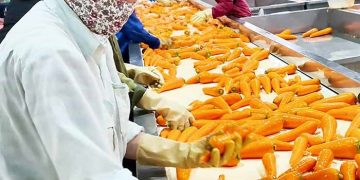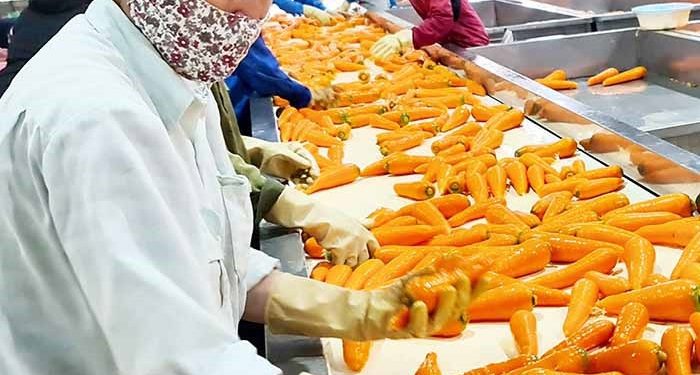Currently, farmers have started harvesting carrots in the main season to prepare for export. The good news for growers is that Korea – one of Vietnam’s main carrot export markets has officially reopened.
At this time, farmers in many growing areas are starting to harvest the main crop of carrots and bring them to Duc Chinh commune (Cam Giang) for preliminary processing and packaging before exporting.
Good news
From the end of December, the farms growing early tea carrots in the provinces of Thai Binh, Bac Ninh… started to harvest. Trucks carrying carrots everywhere poured into Duc Chinh commune. This is also the time when Hai Duong’s carrot barn is the most crowded and bustling of the year.
The agricultural product processing workshop of Duc Chinh Commune Agricultural Service Cooperative – one of the factories with the largest capacity, is always bustling with cars. Here, every day, there are nearly 30 tons of carrots from all over the world. The muddy carrots are put into an automatic washing line, then workers sort them by size and quality, and pack them. More than 200 tons of goods have been transported for consumption at wholesale markets in the country. From the beginning of January until now, the cooperative has received many export orders to Malaysia, Laos and Korea with an output of over 100 tons.
This year, the cold weather came late, but there were many cold days, so the carrots were harvested later than last year. The main consumption is carrots grown on farms outside the province. Currently, farmers in the province have just started harvesting carrots. The price of carrots purchased at the field ranged from 5,000 to 6,000 VND/kg, halving compared to the same period last year. Some areas of early tea yield decreased due to heavy rain at the beginning of the planting season. However, the main carrot output is still 1.7 – 1.8 tons/sao, equivalent to the same period last year, farmers earn about 5 million VND/sao. According to traders, the price of carrots is low because now China is also harvesting the main crop of carrots.
Carrots are harvested late, so exports are also later. From the beginning of January, new businesses began to receive export orders to Malaysia, Thailand and Middle East countries. As of January 8, the export output of carrots in Duc Chinh commune has only reached about 300 tons.
Korea is one of Vietnam’s main carrot export markets. In the winter crop of 2021-2022, the output of carrots consumed here is about 100,000 tons, of which mainly carrots from Hai Duong. For this market, pest control, especially nematodes, is particularly important. From December 21, 2022, this country officially lifted the import ban on a number of Vietnamese agricultural products, including carrots. Previously, at the beginning of October 2022, Korea discovered the nematode radopholus similis in the monstera tree originating from Vietnam and announced to restrict the import of plants originating from our country, including a carrot. The ban being lifted at the beginning of the harvest is a good sign for the carrot growing areas of Hai Duong.
Mr. Nguyen Duc Thuat, Director of Duc Chinh Commune Agricultural Service Cooperative affirmed: “As soon as Korea lifted the import ban, nearly 10 Korean businesses came directly to survey and sign coffee consumption contracts. rather than through domestic exporters. This is the first time that many Korean businesses have directly come to buy carrots from Hai Duong. This proves that the quality of the province’s carrots has been confirmed in the international market.”
Quality control
In recent years, the quality of Hai Duong’s carrots has been maintained stably. Although Korea has announced to restrict the import of carrots due to nematode infections, Hai Duong’s carrots are still exported to other countries and no batch has been detected with radopholus similis nematodes.
Most of the carrot growing areas are produced by farmers according to VietGAP standards, meeting export requirements, including demanding markets such as the European region. Instead of abusing fertilizers and pesticides as before, most farmers now follow the guidelines of the agricultural industry. Residues of pesticides, especially nematodes and residues of Hexaconazole in carrots are strictly controlled, helping businesses feel secure in purchasing and exporting, and at the same time protecting Hai Duong’s carrot brand.
Mr. Nguyen Van Sanh in Dan Trang village, Duc Chinh commune planted 9 sao of carrots. For many years now, his family’s entire carrot growing area has been purchased by businesses for export. Mr. Sanh said: “This year, in addition to early carrot tea affected by heavy rain, so the yield decreased, the main crop of carrot tea still gives stable yield and output”.
Hai Duong currently has about 1,500 hectares of carrots, the output is expected to be about 80,000 tons. In addition, farmers also rent thousands of hectares of land in other provinces and cities to grow carrots. Harvest time starts from the end of December 2022, but it is not until after the Lunar New Year holiday that farmers harvest in full force. About 70-80% of the province’s total carrot production is for export. The main export markets are Korea, Japan and some Southeast Asian countries, the Middle East…
Ms. Luong Thi Kiem, Deputy Director of the Department of Agriculture and Rural Development, said that although the markets have opened and exports are favorable, the control of pesticide residues and pests is a difficult task. must be strictly observed.
“We must ensure the best product quality as well as control the pests, not infecting the pests to the importing countries. This is a long-term problem that farmers and the province’s agricultural sector have to deal with. must be done to increase its reputation in the international market,” said Ms. Kiem.
TRAN HIEN
A source: https://baohaiduong.vn


































